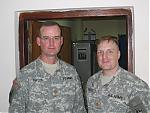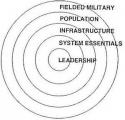WASHINGTON, Dec. 18, 2006 – “Learn” and “adapt” are the key messages of the new Army and Marine Corps Counterinsurgency Field Manual, which just hit the streets.
The Counterinsurgency Field Manual, FM 3-24 and Marine Corps Warfighting Publication 3-33.5, is a unique joint effort between the Army and Marines to put in place doctrine to help operators as they face the challenges of asymmetric warfare.
The manual codifies an important lesson of insurgencies: it takes more than the military to win. “There are more than just lethal operations involved in a counterinsurgency campaign,” said Conrad Crane, director of the U.S. Army Military History Institute, in Carlisle, Pa., and one of the leaders of the effort.
He said the team working on the manual decided early on to emphasize the interagency aspect of counterinsurgency fights. “The military is only one piece of the puzzle,” Crane said. “To be successful in a counterinsurgency, you have to get contributions from a lot of different agencies, international organizations, non-governmental organizations and host-nation organizations. There are so many people involved to make counterinsurgency successful.”
All of these organizations bring important weapons to the campaign, “and you’ve got to bring unity of effort if you can to make it effective,” he said.
Lt. Col. Lance McDaniel, a branch head at the Marine Corps Combat Development Center at Quantico, Va., said the manual is aimed at battalion-level officers and NCOs, but felt that all who read it could gain some insight into the difficulties of a counterinsurgency war. “We see this being part of the pre-deployment training units undergo,” McDaniel said. “Once on the ground they can adapt the ideas from the manual to their particular location and enemy.”
The Army and Marine Corps have shared field manuals in the past, but this is the first on which the two services worked closely to write, both Crane and McDaniel said. “This was a real team effort of Army and Marine writers,” Crane said. “What I tell people is we had about 20 primary writers on the manual and about 600,000 editors.”
Crane said many soldiers and Marines commented on the manual and provided input to the final product. “We received more than 1,000 comments from people actually doing the mission,” he said.
But it didn’t stop with military feedback. State Department employees, CIA officials, academic experts and representatives of the international human rights community contributed insights to the manual, McDaniel said. “I hope the publication will make it easier for other agencies and organizations to work with us,” he said.
Chapter 4, a discussion on Campaign Design, is a unique aspect of the manual. “The Marines brought that to the manual,” Crane said.
Before beginning a campaign, planners must identify the problem that needs solving, then be ready to change the plan as conditions change on the ground, Crane said. “In counterinsurgency, that is so important because it is a complex situation,” he said.
A counterinsurgency campaign is much more complex than a traditional military-on-military conflict. The make-up of the community, the needs of the various groups, the history of the area, traditional allies in the region, and many other things contribute to understanding how to design a counterinsurgency campaign. “It takes a lot more analysis before you jump into it, because if you do the wrong thing, it could have major implications,” Crane said. “You have to be sure you are applying the right solution to the right problem.”
Crane said the idea of campaign design will probably permeate other Army field manuals.
The new counterinsurgency manual uses examples from fighting in Afghanistan and Iraq, but also uses examples from the Napoleonic War, the U.S. experience in Vietnam, and counterinsurgency efforts in the Philippines, Malaya (now Malaysia) and South America.
Crane and McDaniel agree that insurgencies are the wars of the future. The idea of a nation taking on the United States army to army or navy to navy is remote, given the U.S. conventional expertise. “Enemies will make us fight these kinds of wars until we get them right,” Crane said. “Then they’ll switch.”
The manual is informed by Afghanistan and Iraq, but also informed by history, Crane said. “We tried to glean what was useful from the historical record, but also with the realization that there are a lot of things that are new out there, Crane said. “Trying to grapple with the nature of contemporary insurgency was one of the toughest parts of writing it.”
The manual is not limited to operations in Iraq and Afghanistan. “If we’ve created a manual that is just good for Iraq and Afghanistan, we’ve failed,” he said. “This thing has got to be focused on the future and the next time we do this.”
The manual is going to be useful in Iraq and Afghanistan, but much of what the manual covers is already being done in those theaters. “The manual is future-focused,” Crane said. “The manual gives you the tools to do your analysis and the guidelines to apply it with the understanding that every situation is going to be unique.”
It also will be rewritten, as needed, the men said.
Both men said the manual is receiving a good reception. “This is not a doctrine that is being jammed down peoples’ throats,” Crane said.” This is a doctrine that they are demanding.”












Bookmarks